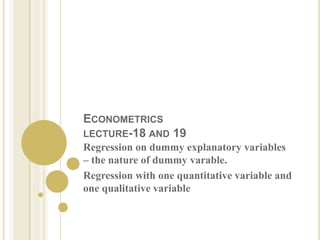Econometrics - lecture 18 and 19
- The document discusses regression analysis using dummy variables to represent qualitative variables like gender, race, or region. Dummy variables take values of 1 or 0 to indicate presence or absence of a quality. - It cautions that if a qualitative variable has m categories, only introduce (m-1) dummy variables to avoid perfect collinearity. The omitted category serves as the base for comparisons. - Regression models containing both quantitative and qualitative variables are called ANCOVA models. They control for the effects of quantitative covariates when examining relationships between dummy and dependent variables. - An example model examines how public school teachers' salaries vary by region and spending per pupil on education, showing the effect of controlling for the quantitative covari

Recommended
Recommended
More Related Content
What's hot
What's hot (20)
Similar to Econometrics - lecture 18 and 19
Similar to Econometrics - lecture 18 and 19 (20)
More from Almaszabeen Badekhan
More from Almaszabeen Badekhan (19)
Recently uploaded
Recently uploaded (20)
Econometrics - lecture 18 and 19
- 1. ECONOMETRICS LECTURE-18 AND 19 Regression on dummy explanatory variables – the nature of dummy varable. Regression with one quantitative variable and one qualitative variable
- 2. THE NATURE OF DUMMY VARIABLES In regression analysis the dependent variable, or regressand, is frequently influenced not only by ratio scale variables (e.g., income, output, prices, costs, height, temperature) but also by variables that are essentially qualitative, or nominal scale, in nature, such as sex, race, color, religion, nationality, geographical region, political upheavals, and party affiliation. Since such variables usually indicate the presence or absence of a “quality” or an attribute, such as male or female, black or white, Catholic or non-Catholic, Democrat or Republican, they are essentially nominal scale variables.
- 3. One way we could “quantify” such attributes is by constructing artificial variables that take on values of 1 or 0, 1 indicating the presence of that attribute and 0 indicating the absence of that attribute. For example, 1 may indicate that a person is a female and 0 may designate a male. Variables that assume such 0 and 1 values are called dummy variables.Such variables are thus essentially a device to classify data into mutually exclusive categories such as male or female. Dummy variables can be incorporated in regression models just as easily as quantitative variables. As a matter of fact, a regression model may contain regressors that are all exclusively dummy, or qualitative, in nature. Such models are called Analysis of Variance (ANOVA) models
- 4. CAUTION IN THE USE OF DUMMY VARIABLES If a qualitative variable has m categories, introduce only (m- 1) dummy variables. If you do not follow this rule, you will fall into what is called the dummy variable trap, that is, the situation of perfect collinearity or perfect multicollinearity. The category for which no dummy variable is assigned is known as the base, benchmark, control, comparison, reference, or omitted category. And all comparisons are made in relation to the benchmark category. The intercept value (β1) represents the mean value of the benchmark category. The coefficients attached to the dummy variables in are known as the differential intercept coefficients because they tell by how much the value of the category
- 5. that receives the value of 1 differs from the intercept coefficient of the benchmark category. If a qualitative variable has more than one category, as in our illustrative example, the choice of the benchmark category is strictly up to the researcher. There is a way to circumvent dummy variable trap by introducing as many dummy variables as the number of categories of that variable, provided we do not introduce the intercept in such a model.
- 6. REGRESSION WITH A MIXTURE OF QUANTITATIVE AND QUALITATIVE REGRESSORS: THE ANCOVA MODELS . Regression models containing an admixture of quantitative and qualitative variables are called analysis of covariance (ANCOVA) models. ANCOVA models are an extension of the ANOVA models in that they provide a method of statistically controlling the effects of quantitative regressors, called covariates or control variables, in a model that includes both quantitative and qualitative, or dummy, regressors.
- 8. TEACHERS’SALARY IN RELATION TO REGION AND SPENDING ON PUBLIC SCHOOL PER PUPIL By maintaining that the average salary of public school teachers may not be different in the three regions if we take into account any variables that cannot be standardized across the regions. Consider, for example, the variable expenditure on public schools by local authorities, as public education is primarily a local and state question. Yi = β1 + β2D2i + β3D3i + β4Xi + ui where Yi = average annual salary of public school teachers in state ($) Xi = spending on public school per pupil ($) D2i = 1, if the state is in the Northeast or North Central = 0, otherwise D3i = 1, if the state is in the South = 0, otherwise
- 9. Yi = 28,694.918 − 2,954.127D2i − 3,112.194D3i + 2.3404Xi se = (3262.521) (1862.576) (1819.873) (0.3592) t = (8.795)* (−1.586)** (−1.710)** (6.515)* R2 = 0.4977 As these results suggest,as public expenditure goes up by a dollar, on average, a public school teacher’s salary goes up by about $2.34. Controlling for spending on education, we now see that the differential intercept coefficient is not significant for either the Northeast and North Central region or for the South.
- 10. PUBLIC SCHOOLTEACHER’S SALARY (Y ) IN RELATION TO PERPUPIL EXPENDITURE ON EDUCATION (X).